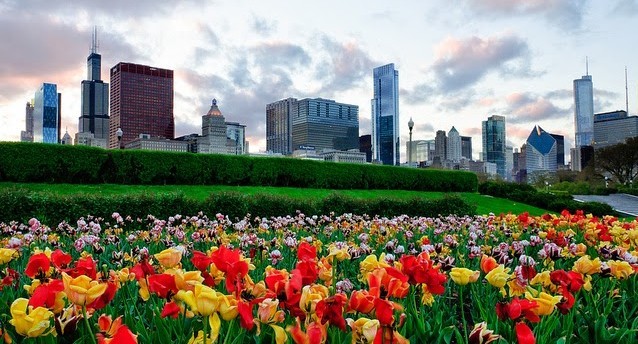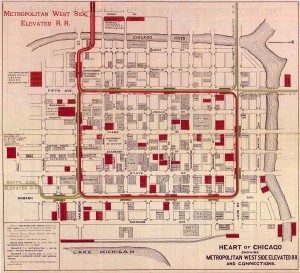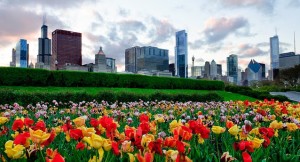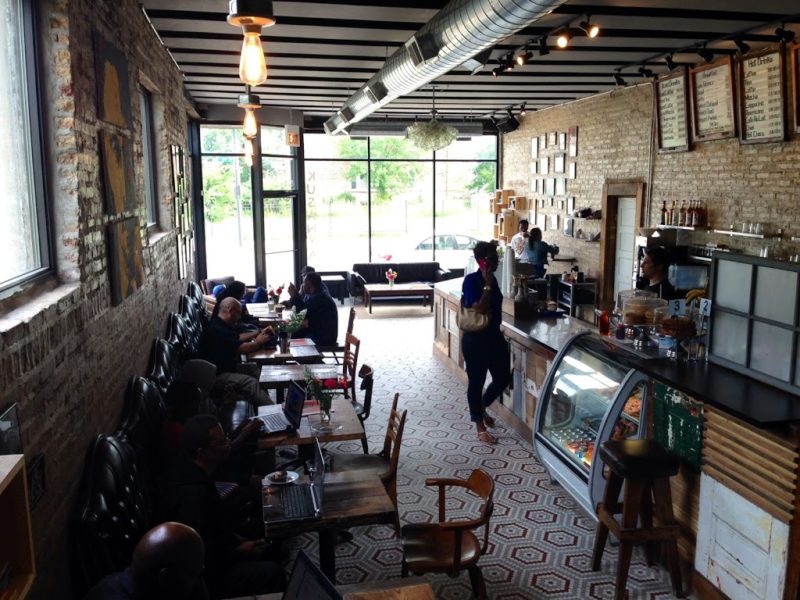
Street Smarts
Welcome to Tuesday Trivia! Each week, we tackle this big, bizarre, wonderful city through a different lens, asking you to answer the tough questions. This week, we’re looking at our fair metropolitan through its streets, from the beloved grid system to the real Six Corners.

An 1898 map of the Chicago Loop and its glorious grid system.
Image from www.chicago-l.org
1. When did the modern-day Chicago grid system first go into effect?
a. 1872
b. 1909
c. 1918
d. 1921
Answer: B. The modern-day grid system dates back to a 1908 proposal by Edward P. Brennan designed to prevent confusion caused by Chicago’s growth and annexation of neighboring towns, its duplicate street names and its non-uniform numbering systems. It was refined and implemented in 1909.
2. Chicago streets have designated numerical values going north, south, east and west. For example, Foster Ave. is 5200 north, 52nd St. is 5200 south and Laramie Ave. is 5200 west. What intersection would be 0x0 according to the Chicago grid system?
a. State St. and Lake St.
b. Ogden Ave. and Kinzie St.
c. Madison St. and State St.
d. Randolph St. and LaSalle St.
Answer: C. When the grid system went into effect, Madison St. became the standard baseline for north/south streets, and State Street for east/west streets. And so they remain to this day.
3. The Chicago grid system is built so that a span of 800 addresses, or eight city blocks, is equivalent to one mile. For example, Pulaski Road (4000 west) is one mile from Kedzie Avenue (3200 west). There is, however, one part of town where the rules don’t apply. Where’s this rule-breaking stretch of road?
a. Madison St. to 31st St.
b. Halsted St. to Western Ave.
c. Martin Luther King Dr. to Ashland Ave.
d. Marquette Rd. to 95th St.
Answer: A. 31st Street is three miles south of Madison Street, with 900 addresses to the mile. The standard grid system rule resumes after 31st Street, thankfully. Bring this fact up at parties, and Chicagoans will nod at you knowingly.
4. Due to diagonal streets like Milwaukee Avenue and Archer Avenue, Chicago has many six cornered intersections. Only one is the true Six Corners. Can you recognize the real deal among these counterfeit six corners?
a. North Ave., Milwaukee Ave. and Damen Ave.
b. Ogden Ave., Chicago Ave. and Milwaukee Ave.
c. Damen Ave., Clybourn Ave. and Diversey Parkway
d. Irving Park Rd., Milwaukee Ave. and Cicero Ave.
Answer: D. The Portage Park intersection of Irving Park Rd., Milwaukee Ave. and Cicero Ave. proudly holds the name Six Corners. The Wicker Park intersection of North Ave., Milwaukee Ave. and Damen Ave. is sometimes referred to as Six Corners, much to the dismay of Portage Park residents and Chicago neighborhood purists.
5. How did Belmont Ave. get its name?
a. It is named for a Civil War battle that took place in Missouri.
b. It is a mispronunciation of the French phrase “beau monde.” Literally translating to “beautiful world,” the phrase colloquially refers to fashionable society.
c. It is named for an early settler of Chicago, Claude Belmont.
d. Clout.
Answer: A. While it might not seem to make any kind of sense for a street in Chicago to be named for a battle in Missouri, there is a legitimate connection between the Battle of Belmont and a famous Illinois resident. Ulysses S. Grant made his debut as a military commander at the Battle of Belmont.
6. Devon Ave. in Rogers Park, like many Chicago streets, has an honorary name. Which of these famous individuals graces Devon with his or her name?
a. Golda Meir
b. Mahatma Gandhi
c. Muhammad Ali Jinnah
d. Sheikh Mujibur Rahman
Answer: Trick question! Different portions of Devon Ave. are actually named for all of these global leaders. Golda Meir’s name graces the part of Devon Ave. that is home to a large Jewish population, while Ghandi, Jinnah and Rahman pay homage to Devon Ave.’s large Indian, Pakistani and Bangladeshi population, respectively.
7. Which intersection was ranked the most dangerous for pedestrian crossings?
a. Cicero Ave. and Chicago Ave.
b. Halsted St., Lincoln Ave. and Fullerton Ave.
c. Milwaukee Ave., North Ave. and Damen Ave.
d. Cottage Grove Ave. and 79th St.
Answer: C. According to an Active Transit Alliance study on pedestrian safety statistics, the Wicker Park trifecta (not Six Corners!) of Milwaukee, Damen and North was ranked the most dangerous place. The other intersections listed were in the top four most dangerous intersections.
8. In 2004, a stretch of Jefferson Street between Monroe St. and Van Buren St. was dedicated to a musical icon of Chicago. To whom was it dedicated?
a. Leonard Chess, founder of Chess Records
b. Frankie Knuckles, “Godfather of House Music”
c. Mavis Staples, soul singer and civil rights activist
d. Howlin’ Woolf, Chicago blues legend
Answer: B. That particular part of Jefferson Street is named for Frankie Knuckles, the beloved DJ and producer. Honorary Frankie Knuckles Way runs past the space where The Warehouse once stood, the club where Frankie Knuckles served as its first music director and where the term “house” music was coined. Bonus fact: August 25, 2004 was declared Frankie Knuckles Day with the help of then-senator, Barack Obama.
9. In The Blues Brothers, Elwood tells his brother Jake that he had a phony address on his driver’s license: 1060 W. Addison St. What can be can be found at 1060 W. Addison?
a. The Billy Goat Tavern
b. The Wrigleyville police precinct department
c. Wrigley Field
d. Mayor Daley’s home address
Answer: C. Elwood’s falsified address ends up sending gaggle of Neo-Nazis to Wrigley field in hot pursuit of the brothers in a later scene.
Bonus Question. Which of these pictures of Chicago in springtime best represents the joy that Chicagoans feel when the weather peaks above freezing?
Trick question! They are all amazing. We have almost survived winter, folks, and the end of slush and gloom and parkas is in sight!
Stay tuned for next week’s trivia!









Pingback: This Week on the Internet | Chicago Ideas Blog